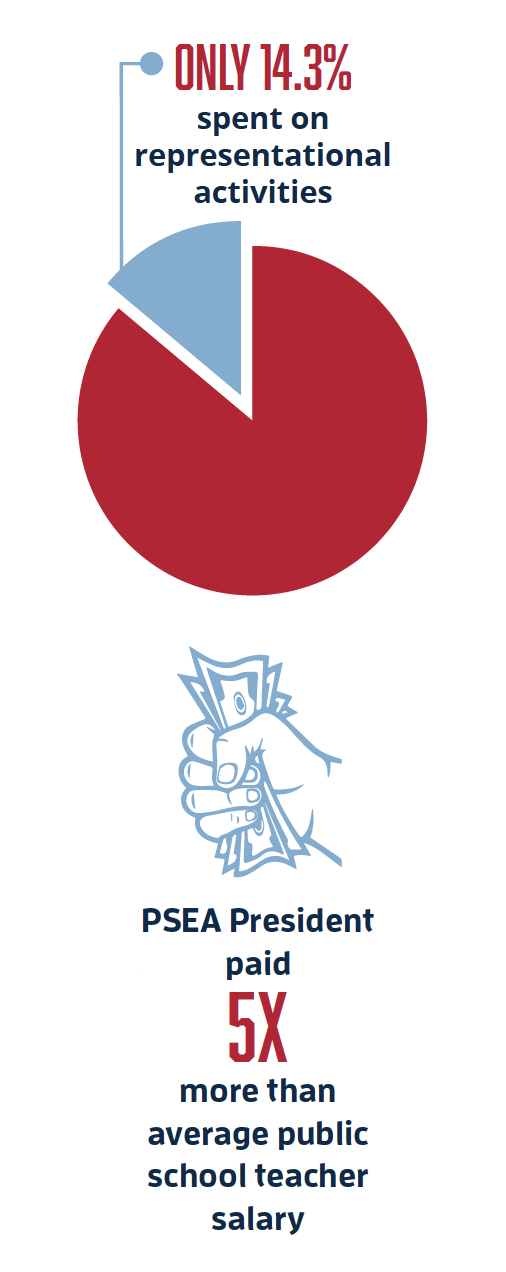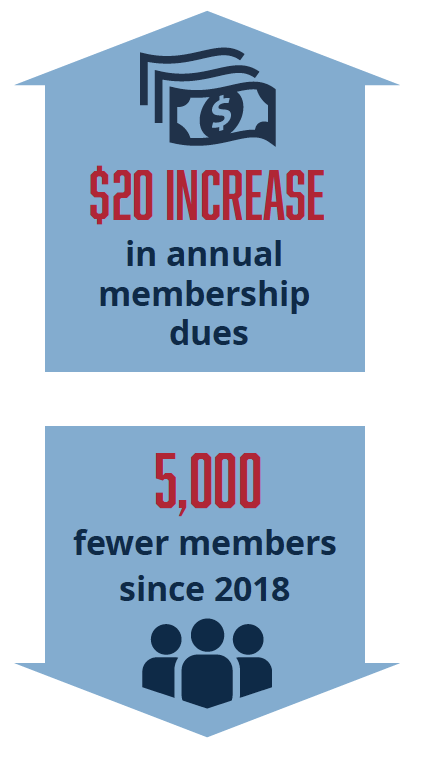The Pennsylvania State Education Association (PSEA) is the largest and most influential public sector union in Pennsylvania. Representing over 175,000 teachers in the Keystone State, PSEA finds itself having to balance its duty as a labor representative with its desire to influence state politics and policy.
As a labor union that represents both public and private sector employees, PSEA files a Form LM-2 financial disclosure with the United States Department of Labor. An examination of the union’s finances can help explain how PSEA is balancing member representation and political activity.
“Representational Activities” are the primary duty of the PSEA. This category describes actions most closely associated with union responsibilities, yet the PSEA decreased overall spending by 5.9 percent on this primary fiduciary duty.
The latest financial disclosure, covering September 1, 2022 to August 31, 2023, reveals that only 14.3 percent of PSEA’s spending went toward representational activities, compared to 20.2 percent in the previous reporting period. In total, PSEA spent $14.7 million representing its members, down from $14.8 million in 2022.

While spending on representation decreased, spending on “political activities and lobbying” increased from $3.2 million in the last reporting period to $5.02 million in the most recent reporting period. Most of this political spending went towards left-wing causes. In addition to political spending classified under the “political activities and lobbying” category, PSEA gave money to political organizations under the “contributions, gifts, and grants” category usually reserved for charitable giving. Examples of political spending classified as charitable giving include:



Based on the PSEA’s own financial reporting, just 20 percent of the union’s spending went to “representational activities,” the category of spending most directly related to labor representation, such as collective bargaining negotiations, handling grievances, and arbitration proceedings. About 71 percent of the PSEA’s overall spending went to running the union: salaries; union employee health and retirement benefits including payments toward the union’s large pension liabilities; general overhead (including expenses such as building security guards); multiple union leadership conferences; and purchase of investments and fixed assets (the last includes land, buildings, and cars).
In 2021-2022, the PSEA spent $3.2 million of membership dues on “political activities and lobbying.” According to federal law, member dues can be used for a variety of political activities, such as get-out-the-vote drives, election mailers, lobbying of legislators, and public marketing campaigns.

Beyond member representation and political spending, spending on operating the union accounted for 47.3 percent of all expenditures, totaling $49 million. This spending went towards union administration, salaries and benefits for PSEA employees, and general overhead expenses incurred while operating the union. Union executive salaries make up a portion of these expenses. During the latest reporting period, PSEA President Rich Askey made $260,271, nearly five times as much as the average public-school teacher in Pennsylvania.
Another significant spending category for PSEA was the purchase of investments. During the 2022–23 reporting period, PSEA purchased nearly $22.2 million in U.S. Treasury Securities and another $11.8 million in marketable securities like stocks, bonds, and mutual funds. Operating the union and purchasing investments accounted for over 75 percent of all PSEA expenditures.
With so little resources allocated to membership support, it is no wonder PSEA is losing membership. Since the 2021 reporting period, PSEA has lost nearly 2,000 members. Since 2018, the union has lost almost 5,000 members. Despite losing membership, PSEA has seen significant growth in revenue and net assets over the same period. From 2021 to 2023, revenue increased from $76 million to $81 million, while the union’s net assets increased from $125.5 million to $161.7 million. This is likely due to increasing membership dues and a concerted effort to make more investments. Since 2021, PSEA’s membership dues have increased by $20 per year.


According to federal law, member dues can be used for a variety of political activities, such as issue advocacy, get-out-the-vote drives, election mailers, lobbying, and public marketing campaigns. The Janus v. AFSCME Supreme Court decision relieves nonmembers from the obligation to pay any dues or fees to the union as a condition of public employment. However, for teachers who remain PSEA members, Janus changes nothing about how union dues are spent: they are still routinely used for political purposes. During the latest reporting period, PSEA reported paying:

PSEA members also pay dues to the National Education Association. For more information on how those dues are spent, see the link below.